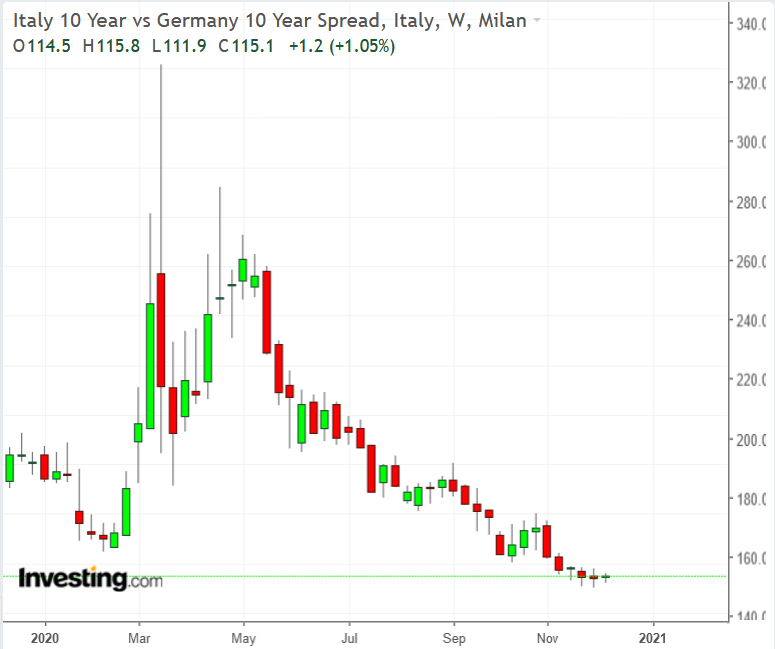The European Central Bank moves to center stage this week, after hinting that it will top up its pandemic emergency purchase program from the current €1.35 trillion. The resurgence of COVID-19 in Europe and the dip into negative inflation rates in the eurozone will keep ECB policymakers from being stingy in the amount they add.
Estimates of the increase are about €500 billion and anything less than that might disappoint investors. The PEPP started with €750 billion in March and a further €600 billion was added in June. Some analysts are forecasting a total expansion of another €1 trillion, though probably not all at once. At this week’s meeting, the expectation is that the program will be extended through next year and perhaps into 2022 from its current expiration in mid-2021.
ECB buying has pushed Italian bond yields to record lows. The benchmark 10-year bond settled at about 0.57% Monday.

Chart powered by TradingView
Because Italy’s bonds still have positive yield and the ECB is supporting prices, the spread to Germany’s bonds has narrowed and analysts forecast it to narrow further.
German bonds are yielding well into negative territory. Perceived as the standard for Europe, they move more often in tandem with US Treasuries. The 10-year Treasury note yield is trending upward as Congress gets closer to agreement on a new stimulus package approaching $1 trillion, creating more debt and requiring more bond issuance, which depresses prices. Bond yields move inversely to prices.
As German bond yields rise in sympathy with Treasury yields and ECB buying and investor demand puts downward pressure on Italian bond yields, the spread between the two eurozone bonds will narrow. Some analysts see it falling from its current 115 basis points below 100 bps, perhaps reaching as low as 90 bps. The more the ECB adds to its PEPP envelope later this week, the likelier that scenario becomes.
Meanwhile, the UK and EU are outdoing each other in Brexit brinksmanship, setting deadlines and pushing them back as negotiators blow hot and cold on reaching a deal for trade when the Brexit transition period expires at the end of this month.
The British government is proceeding full speed with bond issuance to cover the burgeoning pandemic-fueled deficit and is on course to raise more than half a trillion pounds this year. The UK is offering nearly £8 billion in gilts this week as it continues borrowing at a record pace and the Bank of England hoovers up the bonds, supporting prices and keeping yields low.

The stuttering Brexit talks themselves are pushing up bond prices, as the 10-year gilt yield fell more than 5 bps on Monday to 0.295%.
Investors seem to be shrugging off a query to the UK Debt Management Office from Mel Stride, the chairman of the powerful Treasury Select Committee in Parliament, asking whether selling a portion of the gilts via a bank syndicate instead of at auction results in the best price. The DMO revived the syndicate sales in 2009 for large tranches of bond issuance after the financial crisis.
In a letter to DMO head Robert Stheeman, Stride asked whether the indicative prices quoted by the bank syndicate truly represented the best deal for taxpayers. A 40-year gilt sold by a syndicate in September was massively oversubscribed with £49.6 billion in offers for £6.5 billion of bonds and Stride wants to know if DMO is really getting the best price in the face of such demand.
All told, the UK has issued more than £300 billion in gilts via syndication over the past decade. Stride found it peculiar that 58 issues in a row were priced at the tight end of the indicated range, a remarkable performance that made him question whether the indicative price was set too low or whether the banks were manipulating the price of the reference gilt to make it cheaper ahead of pricing.
Whatever the response to Stride’s query, the demand is clearly there as risk-averse investors play it safe. Whether the UK exits the EU with a trade deal or not, the economy is in for a rough ride that will keep investors looking to minimize risk.
